A CAN-Bus Lightweight Authentication Scheme
Abstract
:1. Introduction
- Denial-of-service attacks: An attacker can use the CAN bus arbitration mechanism to inject numerous highest priority message frame IDs, inhibiting the transmission of messages from other ECUs. The attacker can also use error frames to force certain ECUs to become bus-off [14], paralyzing their service. For specific systems (e.g., tire-pressure monitoring systems), their sensors can be connected into an ad-hoc network to initiate wormholes or blackholes to suspend their services [15,16]. In addition, attacks can install malware to paralyze services [17].
- Message tampering: This involves taking control of ECUs by using disguised IDs or fake frames or by conducting replay attacks by replaying a prerecorded frame. Replay attacks cause the receiver to receive an incorrect frame. Because of the plaintext transmissions of park assist systems, the speed and angle of entry can be easily parsed, and consequently, attackers can cause collisions during assisted parking by sending out frames with erroneous speed or angles or by replaying erroneous frames [11]. Our main focus is on message tampering.
- OBD-II was originally intended to enable vehicle maintenance personnel to diagnose the vehicle’s state. Through the OBD interface, maintenance personnel can use the CAN bus to read the status information of every ECU in the vehicle and diagnose any malfunctioning parts. Before the prevalence of OBD-II and the existence of Bluetooth and smart phones, drivers could not conveniently connect devices to the OBD-II. Manufacturers have since added Bluetooth pairing, enabling drivers to see the status of the car’s CAN on their phone. However, this Bluetooth portal has led to an increase in attacks. The OBD interface was not designed with access control mechanisms, and consequently, anyone can obtain information about the vehicle through the OBD-II and even control the ECUs of the attacked vehicle [11,18,19,20]. For example, Miller et al. [11] injected false frames into a CAN bus by using the OBD interface, enabling them to shut down the engine, activate the accelerator, and even control the vehicle’s speed and direction while the vehicle was moving.
- Entertainment systems: In-vehicle entertainment systems are combinations of hardware and software that provide music or video entertainment in a vehicle. In-vehicle entertainment began with sound systems consisting of a radio and a cassette or CD player; these systems now include navigation systems and video players as well as USB, Bluetooth, and WiFi connectivity. In addition to installing malware on CDs, a smart phone, or other removable devices, attacks can install malicious code by using Bluetooth or telephone networks, and even a CAN signal can be used to gain complete control of an ECU [13]. Victims typically do not notice attacks being conducted through Bluetooth or telephone networks, and these types of attacks can spread quickly and be conducted over the internet, producing considerably substantial effects, impacts, and threats. Table 2 presents the routing methods of CAN bus data packets and ECU updating methods used to gain complete control of a vehicle.
2. Related Works
3. Method and Design
3.1. Message Authentication Code (MAC)
3.1.1. Counter-Based MAC
3.1.2. Time-Based MAC
3.1.3. Time Intervals
- In situations when the frame’s own transmission time—that is, , which exceeds a time interval, causing the time difference between the transmitter and the receiver to exceed a time interval, the time counters become desynchronized and fail authentication;
- Each ECU in the CAN may have errors in their time unit. When the vehicle is set, the time error of each ECU gradually increases until finally the time counters become desynchronized and fail authentication. Solutions to these two problems are described subsequently.
3.1.4. Time Counter Synchronization and Offset
3.2. Key Distribution
- (A)
- System initialization. Before the vehicle leaves the factory, the gateway is set to share a key with individual ECUs in the subnet. This key is only used when adding or removing devices. The gateway shares the same group key with all the ECUs in the subnet, and this group key is used to generate session keys.
- (B)
- System reset. When the system is reset, the gateway resets a frame to the ECU group. After receiving this frame, each ECU resets their time counter to zero, and the time counter begins increasing after each time interval. This frame is not attached to a MAC because all the ECUs only receive this frame at the system reset, and not afterwards. Unless the system is reset, even if an attacker sends a reset frame again, the remaining ECUs ignore it.
- (C)
- Initial distribution of keys. After the gateway resets the time counters to zero, it generates a seed used to create group keys. The gateway then uses this seed to create a MAC for the group key shared with every ECU in advance and then broadcasts the MAC to each ECU.
- (D)
- Key updates. Occasionally, the gateway generates the seed for the next group key and then uses the previous group key to create a MAC. This frame is sent to each ECU in the form of a broadcast.
- (E)
- Adding an ECU device. When a new ECU is added, the group key is not resent. However, the new device does not have the previous group key; therefore, the gateway first sends a new encrypted group key to the new device and then sends an encrypted time counter. Subsequently, the gateway updates the key for the remaining ECUs with a new seed. Therefore, the new device can send frames to the other ECUs. The group key that was stored in advance is then changed to the current group key, enabling the new device to update its key.
- (F)
- Removing an ECU device. When an ECU is being removed, because the ECU has the previous group keys, the gateway was allowed to use the key that was shared with every ECU in advance to send a new encrypted group key. The removed ECU cannot decrypt the new group key, even with the old group key. At this time, the prestored group key is changed to the current group key, and the removed device is therefore unable to update its key.
4. System and Protocol
4.1. System Framework: CAN Bus Partitions
4.2. Notations
4.3. System Initialization
4.4. System Reset
4.5. First Distribution of Keys
| Algorithm 1: GW_Startup-Initial distribution of keys: GW broadcast of the group key. |
| Input: , Output: Packet, seed = random64() ; = ; Packet.data = ; Packet.CRC = ; |
| Algorithm 2: ECU_Startup-Initial distribution of keys: ECUs receive the group key. |
| Input: , , Packet Output: ;  |
4.6. Message Transmission
| Algorithm 3: Message_Transmission |
| Input: M, , Output: Packet Packet.data = M ; Packet.CRC = ; |
| Algorithm 4: ECU_Forwarding: ECU transmissions between subnets. |
| Input: M, , Output: ; ; |
| Algorithm 5: : GW transmissions between subnets. |
| Input: , , Gsk, Output: MAC = ;  |
| Algorithm 6: : GW transmissions between subnets. |
| Input: , Gsk, , Output: Packet3 MAC = ;  |
4.7. Key Updates
| Algorithm 7: : Key updates: GWs. |
| Input: , Output: Packet, seed = random64() ; = KDF(, seed) ; Packet.data = Encrypt(, ) ; Packet.CRC = ; |
| Algorithm 8: : Key updates: ECU. |
| Input: , , Packet Output: MAC = ;  |
4.8. Adding a Device
| Algorithm 9: : the new device sends a join request. |
| Input: , Output: n = random32(); ; ; ; |
| Algorithm 10: : the GW responds to the join request. |
| Input: , , , Output: , , MAC = ; 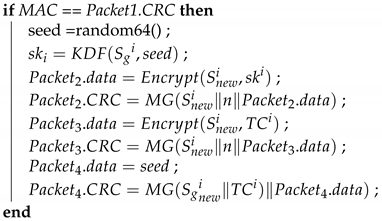 |
| Algorithm 11: : The new device obtains the group key and time counter. |
| Input: , , , n Output: , , MAC1 = ;  |
| Algorithm 12: : The ECUs update their group key. |
| Input: ,, Output: , , MAC = ;  |
4.9. Removing a Device
| Algorithm 13: : The GW sends out the group key individually. |
| Input: , , Output: Packet , seed = random64(); ; ; Packet.data = ; Packet.CRC = ; ; |
| Algorithm 14: : ECUs receive the group key individually when a device is removed. |
| Input: Packet,, Output: , MAC = ;  |
5. Security Analysis
- (A)
- Spoofing attacks: in a typical environment, the frame itself only has CRC protection. Attackers spoof frames on the CAN by using the incorrect data field and deriving the CRC; these spoofed frames can be successfully accepted by an ECU. By adding a MAC to verify the source, attackers must spoof both the frame and the MAC for their spoofed frame to be accepted. Furthermore, attacks must have both the current group key and the current counter to generate the correct MAC. The process for sending keys only involves sending the seed to make the key, and attackers cannot obtain the formula for generating keys; therefore, attacks cannot gain access to the current key. Our MAC only has 15 bits, and attackers attempting to forcibly decrypt the MAC must run through 215 possibilities. Even if the attacker attempts every possibility, they are limited by the slow speed of the CAN bus itself; that is, before running through all the possibilities, the next frame will have reached the target end. This is how our method effectively defends against spoofing attacks.
- (B)
- Replay attacks: Because the frame itself does not have an authentication mechanism, ECUs accept any recorded frame. In our protocol, each message being transmitted creates a MAC on the basis of the current time counter, and different time counters result in different MACs. As such, if an attacker records a previous frame and transmits it, it is not accepted by the ECU. The time counter is involved in both the initial and subsequent transmission of keys to increase the freshness of the MACs. If an attack records a previous frame, because of the different time counter, the prerecorded frame is not successfully verified. In this protocol, the only frame without a time counter or MAC is the reset frame sent out in the beginning; however, this frame is received only once by all the ECUs at the reset and is not accepted or executed again. Consequently, replaying the reset frame does not have any effects. Replay attacks are possible between custom time intervals , and therefore, must be designed in consideration of the CAN speed to impede attacks from launching replay attacks between the time intervals.
- (C)
- Desynchronization: we were concerned about the problem of desynchronization between ECUs in other protocols, whether through desynchronized counters or desynchronized keys. Desynchronized counters directly lead to authentication failures. In the CAN bus, receivers often miss frames, especially in situations with an arbitration mechanism. Essentially, multiple methods involve resetting counters while synchronizing keys to ensure that the time counters synchronize after each interval. However, missed frames still occur, and one missed frame can cause the counter to desynchronize, leading to continued verification failures. Therefore, we chose to use time counters, enabling the counter to always be synchronized. Even if each ECU had a slightly different reset time, resulting in some differences in the time counters, when the receivers fail to authenticate a frame by using its current time counter to calculate the MAC, the ECU attempts to add to or subtract from the time counter to authenticate packets lost because of discrepancies in the time counters. This method does not lead to desynchronized time counters because of missed packets. The PreAuthCode method by which individual keys update their own keys was also considered, but it cannot fully ensure that every counter is perfectly synchronized—that is, if one counter is different from the others, it can no longer synchronize. Therefore, we decided that synchronization would be uniformly performed by the GWs sending out a new seed at fixed times. These two mechanisms in operation ensure that authentications are performed normally even if the counters are slightly desynchronized and that the keys are always synchronized.
6. Experimental Result
7. Implementation in the CAN-FD Environment
| Algorithm 15: CAN-FD_Message_Transmission. |
| Input: M, , Output: Packet Packet.data = M ;  |
8. Conclusions
Author Contributions
Funding
Conflicts of Interest
References
- Zeng, W.; Khalid, M.A.; Chowdhury, S. In-vehicle networks outlook: Achievements and challenges. IEEE Commun. Surv. Tutor. 2016, 18, 1552–1571. [Google Scholar] [CrossRef]
- HPL, S.C. Introduction to the Controller Area Network (CAN); Application Report SLOA101; Texas Instruments: Dallas, TX, USA, 2002; pp. 1–17. [Google Scholar]
- von der Wense, H.C. Introduction to Local Interconnect Network; Technical Report, SAE Technical Paper; SAE International: Warrendale, PA, USA, 2000. [Google Scholar]
- Makowitz, R.; Temple, C. Flexray-a communication network for automotive control systems. In Proceedings of the 2006 IEEE International Workshop on Factory Communication Systems, Torino, Italy, 28–30 June 2006; pp. 207–212. [Google Scholar]
- Fijalkowski, B. Media Oriented System Transport (MOST) Networking. In Automotive Mechatronics: Operational and Practical Issues; Springer: Berlin/Heidelberg, Germany, 2011; pp. 73–74. [Google Scholar]
- Standards-ISO. ISO 11898-3:2006 Road Vehicles—Controller Area Network (CAN)—Part 3: Low-Speed, Fault-Tolerant, Medium-Dependent Interface. 2006. Available online: https://www.iso.org/standard/36055.html (accessed on 31 August 2021).
- Standards-ISO. ISO/CD 11898-1 Road Vehicles—Controller Area Network (CAN)—Part 1: Data Link Layer and Physical Coding Sub-Layer. 2015. Available online: https://www.iso.org/standard/83292.html (accessed on 31 August 2021).
- Standards-ISO. ISO/CD 11898-2:2016 Road Vehicles—Controller Area Network (CAN)—Part 2: High-Speed Medium Access Unit. Available online: https://www.iso.org/standard/67244.html (accessed on 31 August 2021).
- Hoppe, T.; Dittman, J. Sniffing/Replay Attacks on CAN Buses: A simulated attack on the electric window lift classified using an adapted CERT taxonomy. In Proceedings of the 2nd Workshop on Embedded Systems Security (WESS), Newcastle upon Tyne, UK, 22–25 September 2007; pp. 1–6. [Google Scholar]
- El-Rewini, Z.; Sadatsharan, K.; Selvaraj, D.F.; Plathottam, S.J.; Ranganathan, P. Cybersecurity challenges in vehicular communications. Veh. Commun. 2020, 23, 100214. [Google Scholar] [CrossRef]
- Miller, C.; Valasek, C. Remote Exploitation of an Unaltered Passenger Vehicle; Black Hat USA: Las Vegas, NV, USA, 2015; pp. 1–91. [Google Scholar]
- Yadav, A.; Bose, G.; Bhange, R.; Kapoor, K.; Iyengar, N.; Caytiles, R.D. Security, vulnerability and protection of vehicular on-board diagnostics. Int. J. Secur. Appl. 2016, 10, 405–422. [Google Scholar] [CrossRef]
- Checkoway, S.; McCoy, D.; Kantor, B.; Anderson, D.; Shacham, H.; Savage, S.; Koscher, K.; Czeskis, A.; Roesner, F.; Kohno, T.; et al. Comprehensive experimental analyses of automotive attack surfaces. In Proceedings of the USENIX Security Symposium, San Francisco, CA, USA, 8–12 August 2011; Volume 4, p. 2021. [Google Scholar]
- Iehira, K.; Inoue, H.; Ishida, K. Spoofing attack using bus-off attacks against a specific ECU of the CAN bus. In Proceedings of the 2018 15th IEEE Annual Consumer Communications & Networking Conference (CCNC), Las Vegas, NV, USA, 12–15 January 2018; pp. 1–4. [Google Scholar]
- Daimi, K.; Saed, M. Securing Tire Pressure Monitoring System. In Proceedings of the 2018 the 14th Advanced International Conference on Telecommunications Conference, Barcelona, Spain, 22–26 July 2018; pp. 32–37. [Google Scholar]
- Rouf, I.; Miller, R.D.; Mustafa, H.A.; Taylor, T.; Oh, S.; Xu, W.; Gruteser, M.; Trappe, W.; Seskar, I. Security and Privacy Vulnerabilities of In-Car Wireless Networks: A Tire Pressure Monitoring System Case Study. In Proceedings of the USENIX Security Symposium, Washington, DC, USA, 11–13 August 2010; Volume 10. [Google Scholar]
- Avatefipour, O.; Malik, H. State-of-the-art survey on in-vehicle network communication (CAN-Bus) security and vulnerabilities. arXiv 2018, arXiv:1802.01725. [Google Scholar]
- Cho, K.T.; Shin, K.G. Fingerprinting electronic control units for vehicle intrusion detection. In Proceedings of the 25th USENIX Security Symposium (USENIX Security 16), Austin, TX, USA, 10–12 August 2016; pp. 911–927. [Google Scholar]
- Klinedinst, D.; King, C. On Board Diagnostics: Risks and Vulnerabilities of the Connected Vehicle; Technical Report; CERT Coordination Center: Pittsburgh, PA, USA, 2016. [Google Scholar]
- Miller, C.; Valasek, C. Adventures in automotive networks and control units. Def Con. 2013, 21, 15–31. [Google Scholar]
- Aliwa, E.; Rana, O.; Perera, C.; Burnap, P. Cyberattacks and countermeasures for in-vehicle networks. ACM Comput. Surv. (CSUR) 2021, 54, 1–37. [Google Scholar] [CrossRef]
- Nilsson, D.K.; Larson, U.E.; Jonsson, E. Efficient in-vehicle delayed data authentication based on compound message authentication codes. In Proceedings of the 2008 IEEE 68th Vehicular Technology Conference, Calgary, AB, Canada, 21–24 September 2008; pp. 1–5. [Google Scholar]
- Hartkopp, O.; Schilling, R.M. Message authenticated can. In Proceedings of the Escar Conference, Berlin, Germany, 28–29 November 2012. [Google Scholar]
- Woo, S.; Jo, H.J.; Lee, D.H. A practical wireless attack on the connected car and security protocol for in-vehicle CAN. IEEE Trans. Intell. Transp. Syst. 2014, 16, 993–1006. [Google Scholar] [CrossRef]
- Kurachi, R.; Matsubara, Y.; Takada, H.; Adachi, N.; Miyashita, Y.; Horihata, S. CaCAN-centralized authentication system in CAN (controller area network). In Proceedings of the 14th International Conference on Embedded Security in Cars (ESCAR 2014), Hamburg, Germany, 18–19 November 2014. [Google Scholar]
- Ueda, H.; Kurachi, R.; Takada, H.; Mizutani, T.; Inoue, M.; Horihata, S. Security authentication system for in-vehicle network. SEI Tech. Rev. 2015, 81, 5–9. [Google Scholar]
- Nürnberger, S.; Rossow, C. –vatican–vetted, authenticated can bus. In Proceedings of the International Conference on Cryptographic Hardware and Embedded Systems, Santa Barbara, CA, USA, 17–19 August 2016; pp. 106–124. [Google Scholar]
- Schmandt, J.; Sherman, A.T.; Banerjee, N. Mini-MAC: Raising the bar for vehicular security with a lightweight message authentication protocol. Veh. Commun. 2017, 9, 188–196. [Google Scholar] [CrossRef]
- Youn, T.Y.; Lee, Y.; Woo, S. Practical Sender Authentication Scheme for In-Vehicle CAN With Efficient Key Management. IEEE Access 2020, 8, 86836–86849. [Google Scholar] [CrossRef]
- Standards-ISO. AUTOSAR: Specification of Secure Onboard Communication. 2017. Available online: https://www.autosar.org/fileadmin/user_upload/standards/classic/4-3/AUTOSAR_SWS_SecureOnboardCommunication.pdf (accessed on 31 August 2021).
- Fürst, S.; Mössinger, J.; Bunzel, S.; Weber, T.; Kirschke-Biller, F.; Heitkämper, P.; Kinkelin, G.; Nishikawa, K.; Lange, K. AUTOSAR–A Worldwide Standard is on the Road. In Proceedings of the 14th International VDI Congress Electronic Systems for Vehicles, Baden-Baden, Germany, 7–8 October 2009; Volume 62, p. 5. [Google Scholar]
- Fürst, S.; Bechter, M. AUTOSAR for connected and autonomous vehicles: The AUTOSAR adaptive platform. In Proceedings of the 2016 46th Annual IEEE/IFIP International Conference on Dependable Systems and Networks Workshop (DSN-W), Toulouse, France, 28 June–1 July 2016; pp. 215–217. [Google Scholar]
- Radu, A.I.; Garcia, F.D. LeiA: A lightweight authentication protocol for CAN. In Proceedings of the European Symposium on Research in Computer Security, Heraklion, Greece, 28–30 September 2016; pp. 283–300. [Google Scholar]
- Van Herrewege, A.; Singelee, D.; Verbauwhede, I. CANAuth-a simple, backward compatible broadcast authentication protocol for CAN bus. In Proceedings of the ECRYPT Workshop on Lightweight Cryptography, Louvain-la-Neuve, Belgium, 28–29 November 2011; pp. 229–235. [Google Scholar]
- Groza, B.; Murvay, S.; Van Herrewege, A.; Verbauwhede, I. Libra-can: A lightweight broadcast authentication protocol for controller area networks. In Proceedings of the International Conference on Cryptology and Network Security, Darmstadt, Germany, 12–14 December 2012; pp. 185–200. [Google Scholar]
- Ziermann, T.; Wildermann, S.; Teich, J. CAN+: A new backward-compatible Controller Area Network (CAN) protocol with up to 16× higher data rates. In Proceedings of the 2009 Design, Automation & Test in Europe Conference & Exhibition, Nice, France, 20–24 April 2009; pp. 1088–1093. [Google Scholar]
- Martinelli, F.; Mercaldo, F.; Nardone, V.; Santone, A. Car hacking identification through fuzzy logic algorithms. In Proceedings of the 2017 IEEE International Conference on Fuzzy Systems (FUZZ-IEEE), Naples, Italy, 9–12 July 2017; pp. 1–7. [Google Scholar]
- Levi, M.; Allouche, Y.; Kontorovich, A. Advanced analytics for connected car cybersecurity. In Proceedings of the 2018 IEEE 87th Vehicular Technology Conference (VTC Spring), Porto, Portugal, 3–6 June 2018; pp. 1–7. [Google Scholar]
- Wang, C.; Zhao, Z.; Gong, L.; Zhu, L.; Liu, Z.; Cheng, X. A distributed anomaly detection system for in-vehicle network using HTM. IEEE Access 2018, 6, 9091–9098. [Google Scholar] [CrossRef]
- Yang, Y.; Duan, Z.; Tehranipoor, M. Identify a Spoofing Attack on an In-Vehicle CAN Bus Based on the Deep Features of an ECU Fingerprint Signal. Smart Cities 2020, 3, 17–30. [Google Scholar] [CrossRef]
- Zhang, H.; Meng, X.; Zhang, X.; Liu, Z. CANsec: A practical in-vehicle controller area network security evaluation tool. Sensors 2020, 20, 4900. [Google Scholar] [CrossRef] [PubMed]
- Andersson, R. Combining Anomaly- and Signature based Algorithms for Intrusion Detection in CAN-bus. Bachelor’s Thesis, Faculty of Technology and Society (TS), Malmö University, Malmo, Sweden, 2021. Available online: https://www.diva-portal.org/smash/record.jsf?dswid=2720&pid=diva2%3A1566210 (accessed on 25 October 2021).
- Cena, G.; Bertolotti, I.C.; Hu, T.; Valenzano, A. Improving compatibility between CAN FD and legacy CAN devices. In Proceedings of the 2015 IEEE 1st International Forum on Research and Technologies for Society and Industry Leveraging a Better Tomorrow (RTSI), Turin, Italy, 16–18 September 2015; pp. 419–426. [Google Scholar]
- GmbH, R.B. CAN XL News Text|Bosch Semiconductors. 2020. Available online: https://www.bosch-semiconductors.com/news/t-newsdetailpage-4.html (accessed on 31 August 2021).
- Rivest, R.; Dusse, S. RFC 1321: The MD5 Message-Digest Algorithm; Internet Engineering Task Force (IETF): Fremont, CA, USA, 1992; Available online: https://www.ietf.org/rfc/rfc1321.txt (accessed on 25 October 2021).
- Bider, D.; Baushke, M. RFC 6668: SHA-2 Data Integrity Verification for the Secure Shell (ssh) Transport Layer Protocol; Internet Engineering Task Force (IETF): Fremont, CA, USA, 2012; Available online: https://www.ietf.org/rfc/rfc6668.txt (accessed on 25 October 2021).
- M’Raihi, D.; Bellare, M.; Hoornaert, F.; Naccache, D.; Ranen, O. RFC 4226: HOTP: An HMAC-Based One-Time Password Algorithm; Internet Engineering Task Force (IETF): Fremont, CA, USA, 2005; Available online: https://www.ietf.org/rfc/rfc4226.txt (accessed on 25 October 2021).
- Eastlake, D., 3rd; Jones, P. RFC 3174: Us Secure Hash Algorithm 1 (SHA1); Internet Engineering Task Force (IETF): Fremont, CA, USA, 2011; Available online: https://www.ietf.org/rfc/rfc3174.txt (accessed on 25 October 2021).
- Klebe-Klingemann, R.; Webermann, H. Migration from Classical CAN to CAN FD. CAN Newsl. 2021, 2021, 27–29. [Google Scholar]
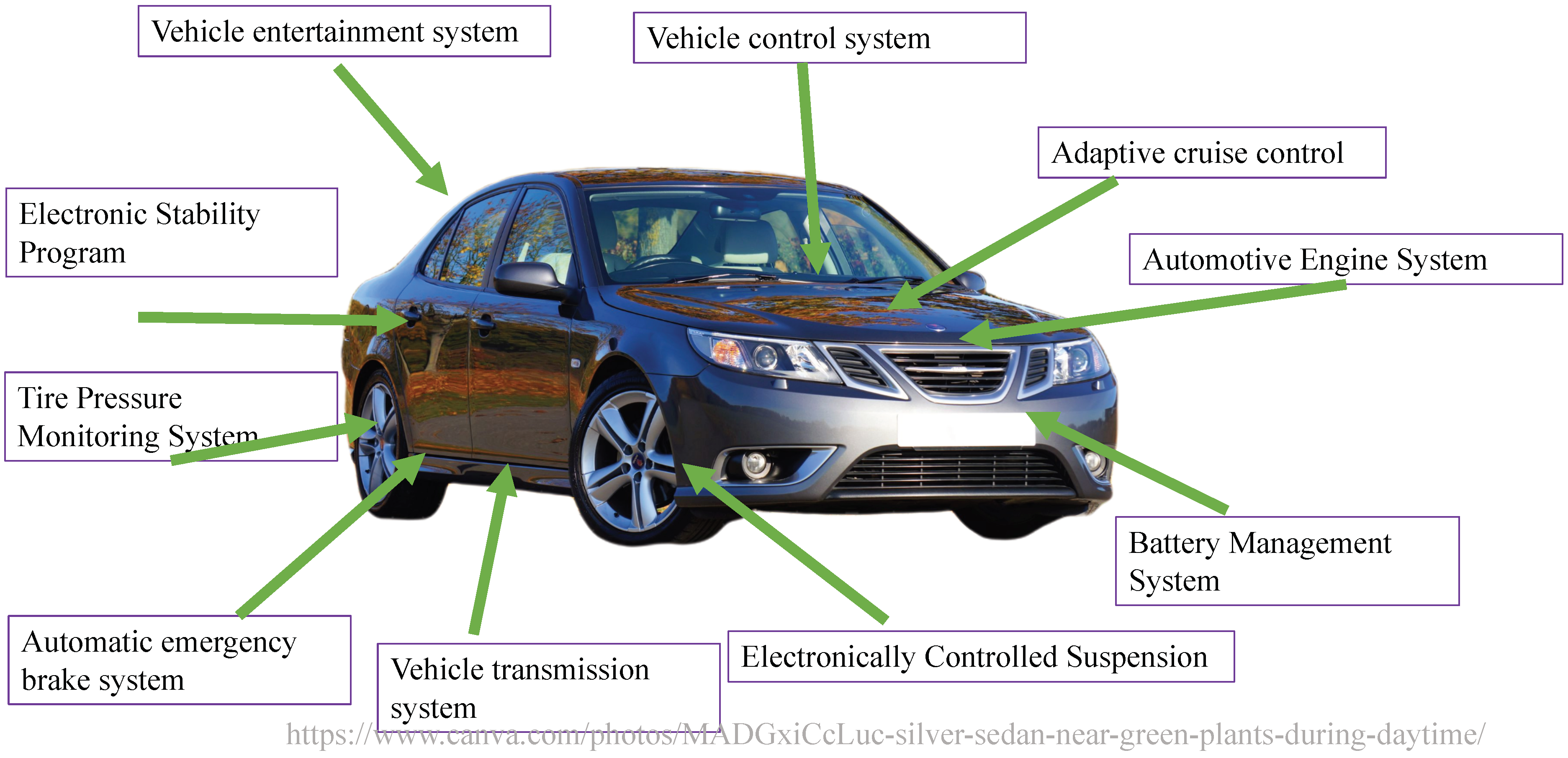

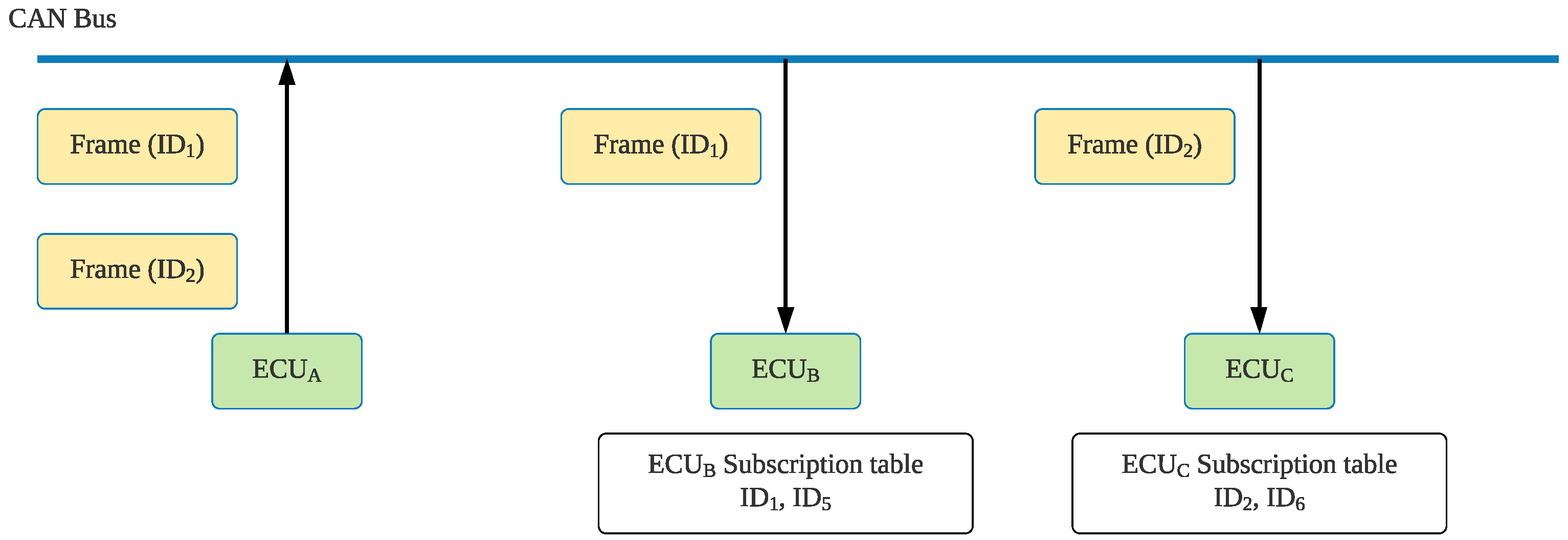




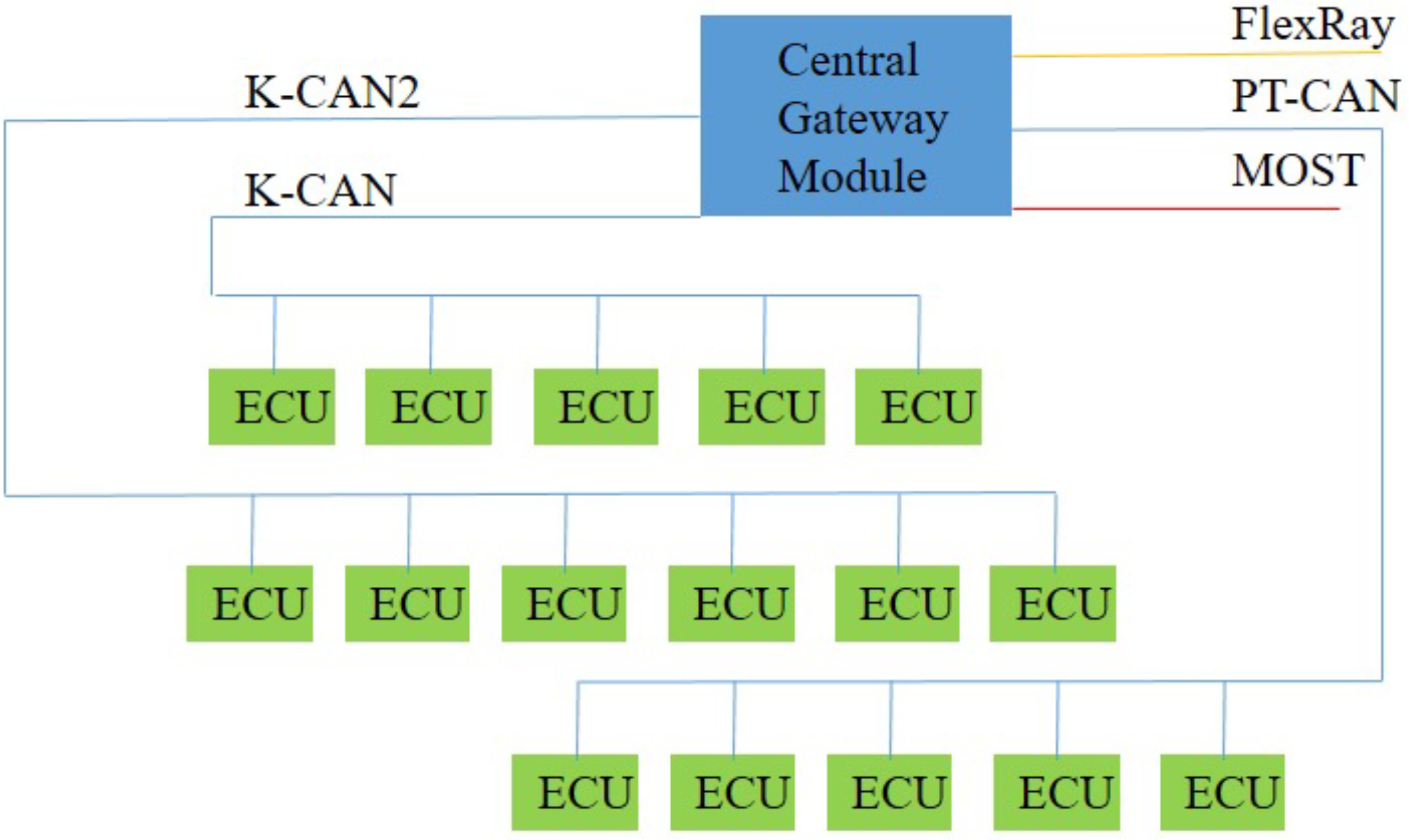

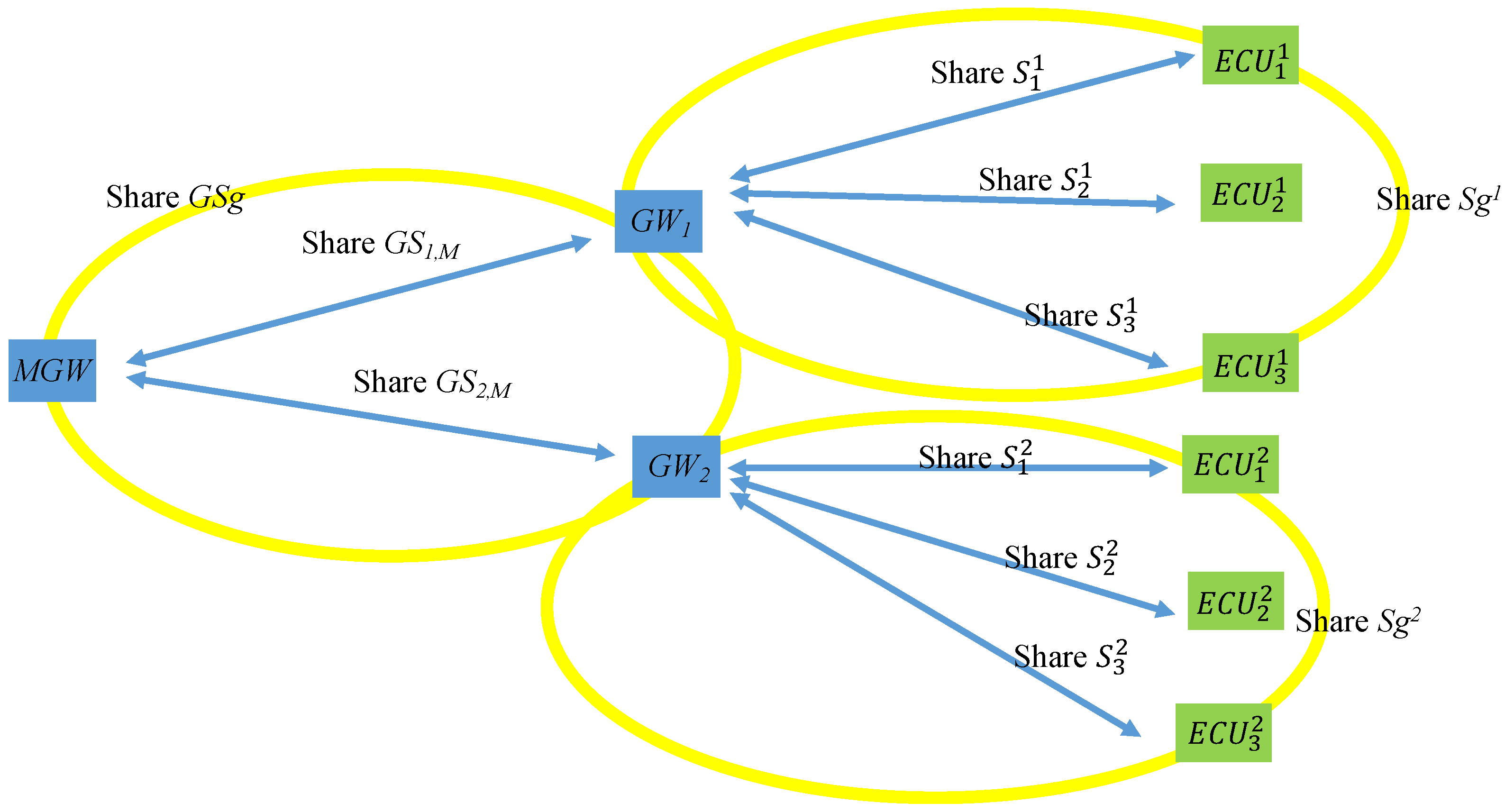





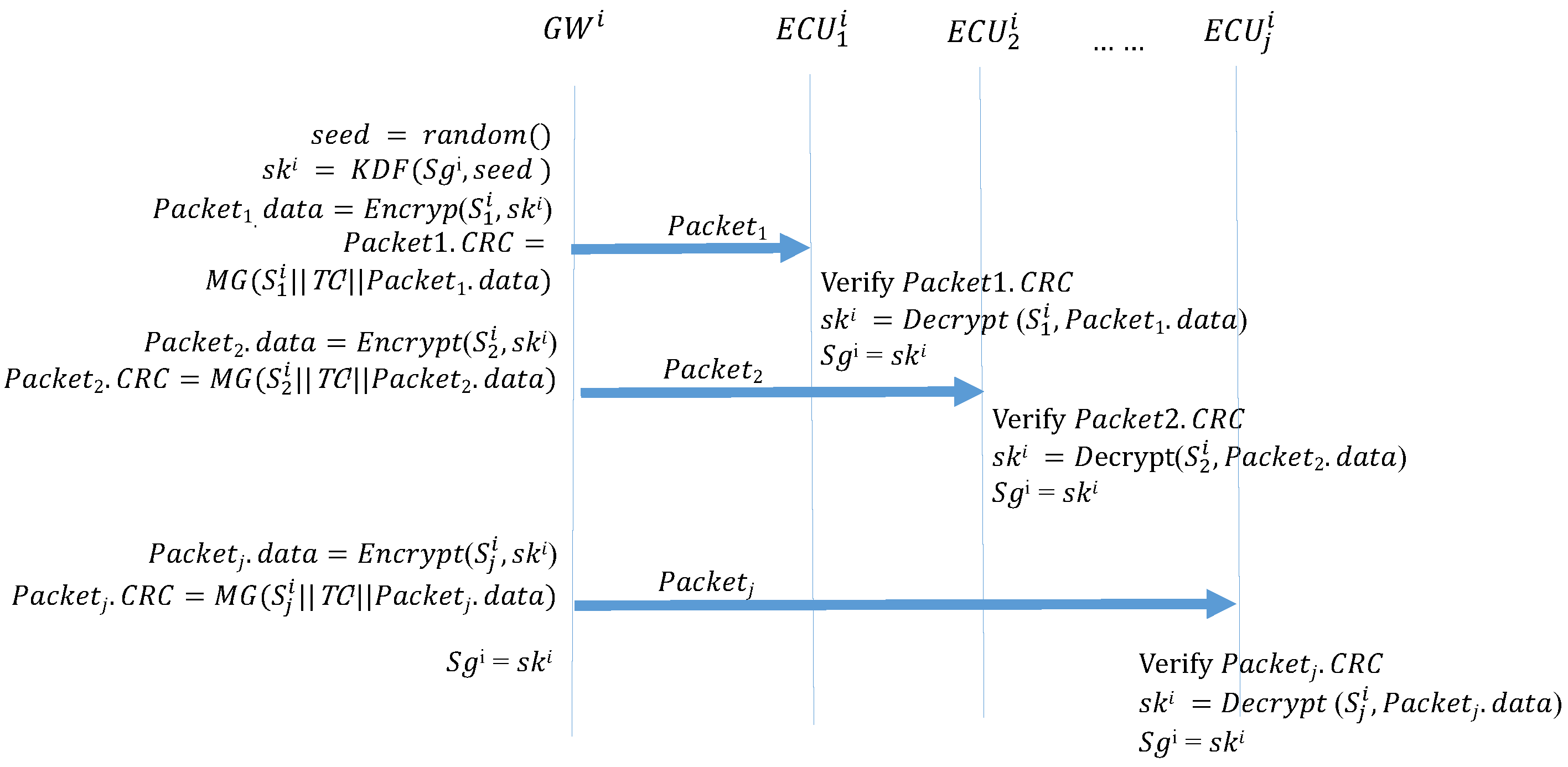


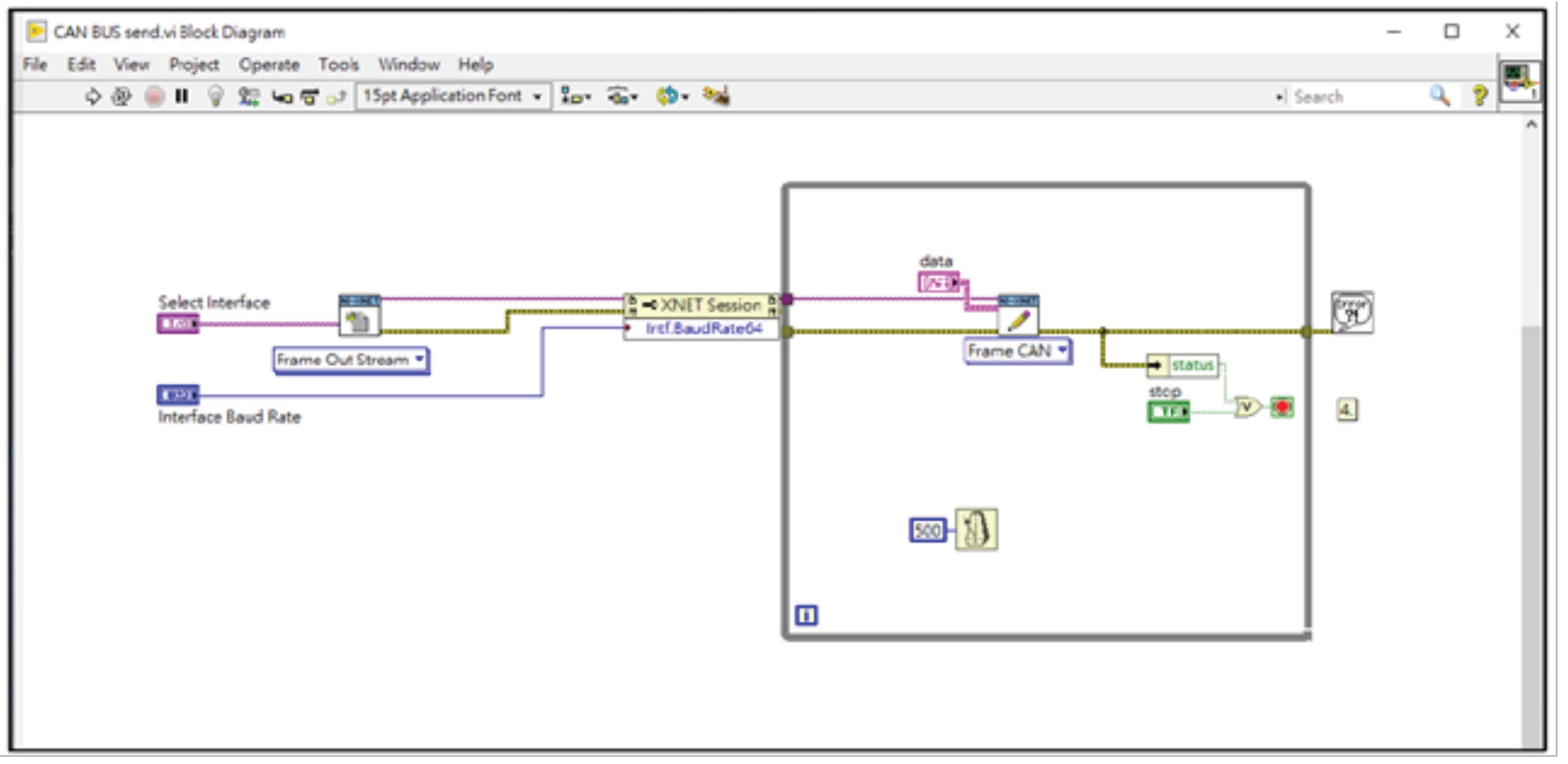
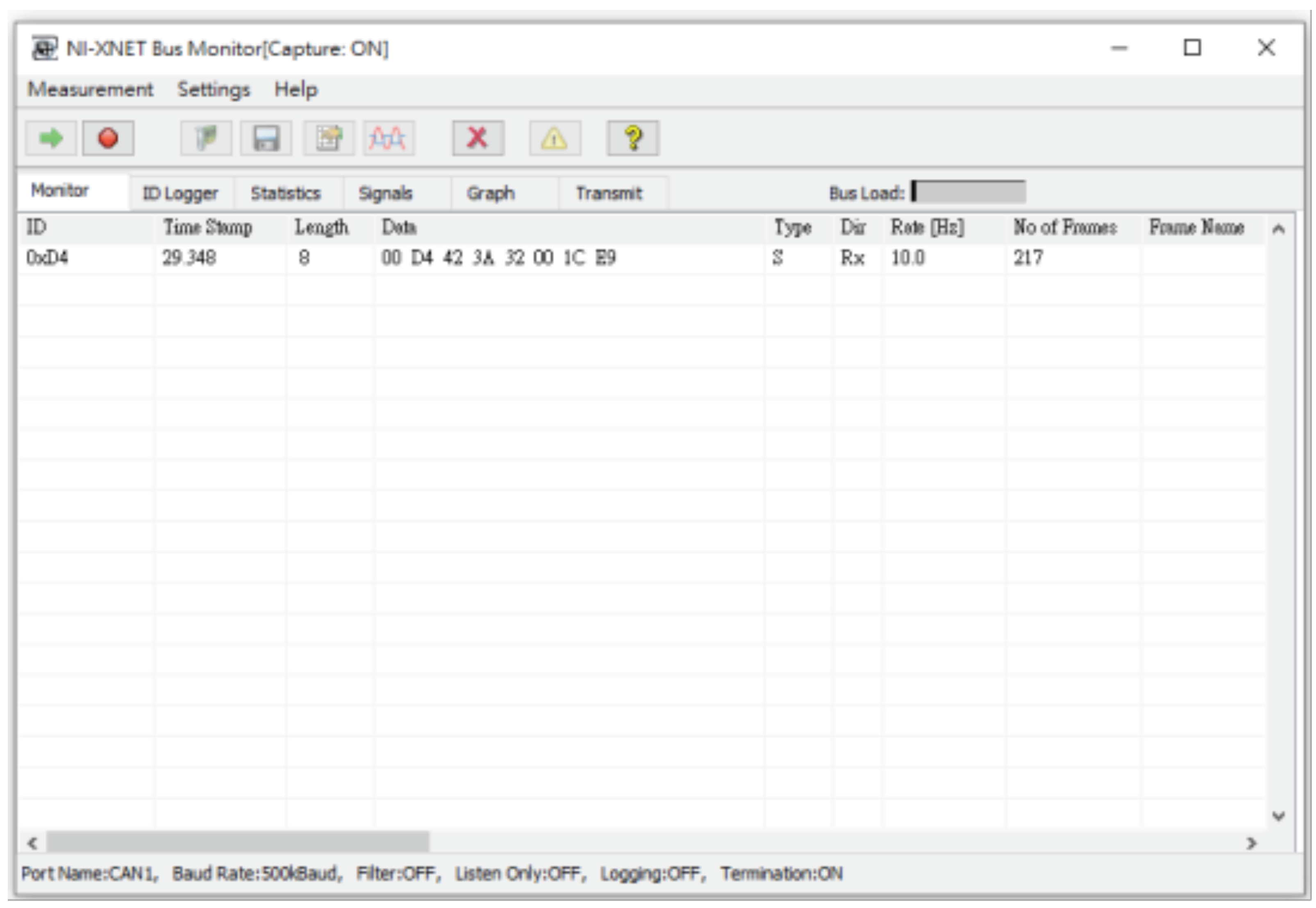

| Error Type | Description |
|---|---|
| bit error | The transmitted data is inconsistent with what is presented in the bus; therefore, an error frame is sent out. |
| stuff error | When six consecutive identical bits are detected, an error frame is sent out. |
| CRC error | An error frame is sent out in response to a CRC error. |
| form error | If the delimiter bit is 0, an error frame is sent out, starting with the next bit. |
| acknowledgment error | The transmitter sends out an error frame if a response is not received after the ACK field. |
| Channel of Infiltration | Method of Implementation | Scope |
|---|---|---|
| OBD-II interface | Connects to the attack device directly through the OBD-II interface | Small |
| CD player | Installs malware through updates | Small |
| PassThru automotive reprogramming device | Connects to a reprogramming device through WiFi and installs malware | Large |
| Bluetooth | Installs malware through overflow attacks | Large |
| Bluetooth | Eavesdrops on the message authentication code (MAC) address and forcibly decrypts the PIN | Small |
| Telephone network | Uses a laptop or smart phone to access the automobile and install malware through overflow attacks | Large |
| Symbol | Description |
|---|---|
| The ith group under CAN bus. | |
| The gateway that manages the bus. | |
| The main gateway that manages all gateways. | |
| The jth ECU in the bus. | |
| The pre-shared key between and . | |
| The sent frame. | |
| The pre-shared keys for all ECUs and the in the bus. | |
| The key shared by and . | |
| The session key used by the ECUs in bus. | |
| The session key used in the GW group. |
Publisher’s Note: MDPI stays neutral with regard to jurisdictional claims in published maps and institutional affiliations. |
© 2021 by the authors. Licensee MDPI, Basel, Switzerland. This article is an open access article distributed under the terms and conditions of the Creative Commons Attribution (CC BY) license (https://creativecommons.org/licenses/by/4.0/).
Share and Cite
Luo, J.-N.; Wu, C.-M.; Yang, M.-H. A CAN-Bus Lightweight Authentication Scheme. Sensors 2021, 21, 7069. https://doi.org/10.3390/s21217069
Luo J-N, Wu C-M, Yang M-H. A CAN-Bus Lightweight Authentication Scheme. Sensors. 2021; 21(21):7069. https://doi.org/10.3390/s21217069
Chicago/Turabian StyleLuo, Jia-Ning, Chang-Ming Wu, and Ming-Hour Yang. 2021. "A CAN-Bus Lightweight Authentication Scheme" Sensors 21, no. 21: 7069. https://doi.org/10.3390/s21217069
APA StyleLuo, J.-N., Wu, C.-M., & Yang, M.-H. (2021). A CAN-Bus Lightweight Authentication Scheme. Sensors, 21(21), 7069. https://doi.org/10.3390/s21217069








